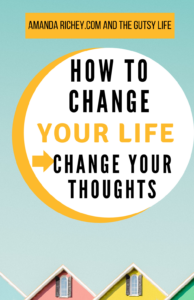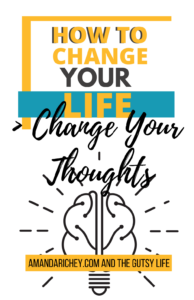
Everything in your life begins with a thought, and thus changing your life will require changing your thoughts.
This may sound extreme, but every action we take is a response to a thought in our brain. We think a thought and then our brain produces an emotional response, which then prompts us to either take action or not take action based on the thought. At the root of our individual choices and behaviors are basic instincts and these basic instincts are controlled by our subconscious thoughts. To change these subconscious thoughts, we need to understand the brain and how it works.
The Brain and How it Works
Our brain consists of two parts, a conscious mind, and a subconscious mind. Our conscious mind is controlled by the prefrontal cortex, a section of our brain located right behind our forehead. This region is responsible for decision making, self-control, willpower, and regulating behavior, and does not fully develop until after puberty.
Our subconscious mind is fully developed at birth, and is controlled by the basal ganglia, which are responsible for emotions, habits, behavior, basic instincts, and ‘habit loops’, or ingrained behaviors you preform unconsciously.
Our brain will travel a path (neural) again and again because it wants to save energy and because it knows that path is safe and easy. This creates a deeply entrenched neural pathway that the brain can then move to the subconscious to be preformed automatically, again saving energy. This automation becomes a habit-loop.
Many of our thoughts and actions are habit-loops, or preformed subconsciously. The bad news is that our subconscious has no analytical filter and thus believes everything it is told, and therefore many of our subconscious habits are based on ‘beliefs’ that may not actually be true (limiting beliefs). The good news it that changing your thoughts is possible, you just have to create new neural pathways.
How to Create Anything You Want in Life
You can create anything you want in life when you understand that; your thoughts create your results in life, those thoughts are subjective, and you control your thoughts, and thus, you can chose which thoughts to have and which ones to let go of. This is not affirmations or manifestation; this is based in behavioral sociology a neuroscience. The process is:
Form new neural pathways with new thoughts.
Create new habit-loops which become your actions.
Actions create a new mindset which leads to new results.
So simple right?
But, to create new thoughts we have to differentiate between facts, thoughts, and feelings. Chances are you may be a bit confused about what constitutes a fact a thought and a feeling. So, let’s talk about what they actually are!
What is a thought and What is a Fact?
A thought is just a sentence in your mind. Any language that goes through your mind is a thought. The thoughts have come from many places; society, your upbringing, your learned experience, your peers. But thoughts are not facts. A thought is a subjective interpretation of your circumstance. There are no right or wrong feelings or thoughts. There are generally certain feelings that tend to go with certain thoughts, but they aren’t always the same for everyone.
Thought: A thought is an interpretation of a fact or circumstance. It is subjective. It is not provable. It is an opinion. Your opinion.
Fact: A fact is neutral. It is provable. It is not up for debate.
Fact: I weigh 140lb.
Thought: I am over weight
Thought: I should weigh less
Thought: I feel overweight (not a feeling)
Fact: I woke up at 8:30am
Thought: I woke up late.
Thought: I woke up early (see how it is dependent on the person!)
What is a feeling?
It is a physical sensation in your body.
ONE WORD.
Heart racing, sweaty palms, tight shoulders: anxious
Butterflies in your stomach, heart racing: nervous
Tight shoulders, tight jaw, heat, clenched fists: anger
That is it; ONE WORD
What causes your feelings are your thoughts. Your brain has a thought. You may be conscious of it or unconscious of it. That thought directs your brain as to what sensations to cause in your body via releasing hormones: example- adrenaline and cortisol. Those hormones created physical changes and sensations in your body—your heart rate gets faster, your muscles tense up in your chest, your palms get sweaty.
Those sensations are the manifestation of anxiety in your body. And the anxiety- the feeling, was caused by a thought that went through your brain. We have a tendency in English to make a statement that starts with the words ‘I feel’ but those are not feelings those are thoughts.
For example:
I feel like I am a failure.
That is a thought. The emotion or feeling might be; hopeless, anxious, despair (depending on the person).
Why Differentiate Between Facts, Thoughts, and Feelings?
Why is it important to distinguish between facts, thoughts, and feelings? Because almost every action we take is a response to either stop or start a certain feeling. That might sound extreme, but at the root of our individual choices and behaviors are basic instincts moving us towards pleasure and way from pain. Because thoughts create our feelings, to change our feelings we need to change our thoughts. To do this it is critical to really understand the difference between a fact (something provable and beyond our control) and a thought (within our control), and then you can change what is in your control-your thoughts.
How to Change Your Thoughts: a Thought Model
A thought model is a five-step process to identify what thought you are having so that you can make an informed decision about whether you want to keep the thought or how or what you need to change about the thought.
C-circumstance (this is the fact- the neutral circumstance)
T– Thought (the interpretation of circumstance (a sentence)
F– Feeling (the sensation in our body, one word: anxious, scared, happy-derived from the thought)
A– Action (the action or inaction you take when you have that feeling)
R– Result (what is created in your life as a result of the actions. Usually feeds back into the thought)
Example:
C: I have two clients
T: I don’t have enough clients
F: anxious
A: avoidant, busy work, distractions
R: do not find more clients because you are distracted and not focused on productive work and thus continue to feel anxious and think you need more clients
C: I have two clients
T: I have enough clients
F: grateful
A: I am open and helpful. I listen and treat them with respect. I have patience and time for them.
R: they are happy clients. I take care of their needs. They give me great referrals.
How to Create Your Own Thought Model
Ask: what am I feeling about this circumstance?
C: I have two clients
F: ???
>>>anxious, nervous, scared
A: when I feel anxious I am avoidant
when I feel nervous I try to control
when I feel scared I doubt myself
Now that you know what you are feeling ask:
What am I thinking?
C: I have two clients
F: anxious, nervous, scared
A: when I feel anxious I am avoidant
when I feel nervous I try to control
when I feel scared I doubt myself
T: what is a thought that leads me to feel
anxious: I do not have enough clients
nervous: there are not enough clients out there
scared: I will never get any clients
Now ask:
Which thought feels true to me right now?
Is it serving me?
Do I want to keep it?
No!
What thought do you want to have instead? This is the time to create a goal thought. A goal thought is something you what to believe but DON’T YET.
Example:
There are more than enough clients.
I have all I need.
There are many people who want to work with me.
etc.
But, I want you to use caution here! This is not an affirmation! Affirmations often don’t work because they are too aspirational and you do not believe them. Your brain needs something it can at least believe even if it is a stretch because the brain does not like new, different, or difficult things.
To reach a goal thought it helps to first start with a neutral thought or a thought that will eventually get you to the goal thought. Remember, you have to practice a thought over and over to create a new neural pathway and erase the old, non-productive, neural pathway (limiting belief).
Sometimes, you have to start WAY back with a really neutral thought.
Example:
I have clients.
There are people out there who want to buy what I sell.
I am willing to believe there are enough clients.
etc.
This needs to be believable to you!
Think the thought and close your eyes. How does it feel? Does it feel true? Positive? Great!
Neutral? Good.
Negative? Eye roll? Chose another!
Practice this thought A LOT before moving on to the goal thought. This could take days or months before this neutral thought becomes automatic and you are ready to start practicing the goal thought.
Conclusion
The key to making huge changes in your life is understanding that you create your thoughts and feeling, which in turn drive your actions, which create the results you have in your life. The good news is that you can change those thoughts to create new results in your life. But, you have to be open to challenging your thoughts. You have to be open to the idea that your thoughts are not facts and can therefore be challenged. This is hard. Our thoughts often feel like who we are, and we have spent a lifetime believing some of them. Change will be slow. Try taking a step back and just questioning an automatic thought you have.
Just ask: Is this true for me? What else could be true?
Even just taking the time to identify the ACTUAL feeling you are experiencing can be a good first step. So often we think we know how we feel but those are just more thoughts (see previous examples). ONE WORD. A bodily response; anxious, scared, hopeless, grateful etc.
All of this is new and brains hate new things. Do not be surprised if your brain resists. Keep questioning and observing, the more you practice this, the easier it will be to change your thoughts and change your life.
And if you want more help with this, hop on a 45 min call with me and we will uncover one limiting belief holding you back and one action step to take right now to get you moving towards the things you actually want in life!



